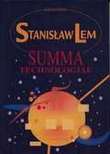
Lem was a giant of mid-20th-century science fiction, in a league with Arthur C. Clarke, Isaac Asimov and Philip K. Dick. And he addressed many of the themes they did: the meaning of human life among superintelligent machines, the frustrations of communicating with aliens, the likelihood that mankind could understand a universe in which it was but a speck.
Ben Sisario, „The New York Times”
Lem is capable of an amazing richness of image and a great knack for characterization. He is wildly comic, he is sardonic, perplexing, insightful.
Theodore Sturgeon, „The New York Times Book Review”
Lem, the Polish author, has been praised as the world's greatest writer of science fiction. Mr. Lem has no equal in his literary explorations of machines and their physical and philosophical potentialities.
Philip J. Farmer, „The New York Times Book Review”
Since Mr. Lem is a world class author, comparisons between the great Polish author Joseph Conrad (who wrote in English) and Mr. Lem (who writes in Polish) are pertinent. Both are deeply pessimistic, but Mr. Lem (like Mark Twain) uses humor as an instrument to deal with the tragic and the inevitable.
Philip J. Farmer, „The New York Times Book Review”
All books by this Polish master of intellectual science fiction should come with a label on the cover warning: ''Handle With Care.'' Mr. Lem is a moralist, an ironist, a man of wide erudition (in both science and literature) who has little patience with the shortcomings of his fellow man.
Gerald Jones, „The New York Times Book Review”
As he moves further away from personal relations, and casts a more sardonic eye on the tricks that humanity's Faustian intelligence plays on itself, Mr. Lem has come to identify with such writers as Swift and Voltaire.
Paul Delany, „The New York Times Book Review”
The mordant Mr. Lem, after all, is Poland's best-known writer in the West, a Jorge Luis Borges for the Space Age, who plays in earnest with every concept of philosophy and physics, from free will to probability theory.
John Leonard, „The New York Times Book Review”
Starting at the very edge of current theories of artificial intelligence, communications, cosmology and nuclear strategy, he soars out into dizzy flights of speculation, grafting one field onto another to populate whole new realms of possibility.
John Leonard, „The New York Times Book Review”
Over the last three decades he has created a body of profoundly speculative writing that - even sometimes at a double remove from us by way of German or French translations - has retained such intellectual bite, such rigorous wit, such deadly playful tightrope walking as to make him a modern European version of Swift or Voltaire.
Peter S. Beagle, „The New York Times Book Review”
 Among Lem's essays Summa Technologiae occupies a central position, leaving behind cybernetic Dialogs, Fantastyka i Futurologia, Filolozofia Przypadku (an attempt at a "general theory of everything"). These other works are no less interesting, however Summa as a logical argument is "closed". It deals with problems that are even more important now than when the book was written - these issues are the most fascinating fulfillment of Lem's prognoses in the field of culture and technology.
Among Lem's essays Summa Technologiae occupies a central position, leaving behind cybernetic Dialogs, Fantastyka i Futurologia, Filolozofia Przypadku (an attempt at a "general theory of everything"). These other works are no less interesting, however Summa as a logical argument is "closed". It deals with problems that are even more important now than when the book was written - these issues are the most fascinating fulfillment of Lem's prognoses in the field of culture and technology.
Dialogs are partly "submerged" in an abstract of a philosophical dispute and current political topics; Fantastyka i Futurologia deals with problems of science fiction as a genre and its - usually dishonest - relationship with science. Filozofia Przypadku "erects a building of outlook" searching for structures common to biological evolution, history, culture, art, etc. In this respect Summa Technologiae is different: it is a summa and a "building", but in the sense of futuristic architecture. It presents daring hypotheses, shows the way, which -according to the author - human technological thought and culture will follow in the future.
 Over twenty of Stanislaw Lem's works reached a print-run exceeding 30 million copies. These can be assigned to the following categories:
Over twenty of Stanislaw Lem's works reached a print-run exceeding 30 million copies. These can be assigned to the following categories:
1. Eden (1959), Return From the Stars (1961), Solaris (1961), The Invincible (1964), His Master's Voice (1968), Tales of Pirx the Pilot (1968) are works serious in tone, following the classic science-ficion route, broadened and perfected by Lem.
2. Grotesque works, hillarious on the surface, frequently styled as traditional literary forms (tales, a memoir, a philosophical tale): The Star Diaries (1957), Memoirs Found in a Bathtub (1961), The Cyberiad (1965), Inspection at the Scene of a Crime (1982), Peace on Earth (1987).
3. The Investigation, published in 1959, lies somewhere between a science-ficiton novel an a detective story, it is a peculiar negative of a detective romance. The Chain of Chance was published in 1976, which Lem considered a better, more convincing version of The Investigation.
4. Lem describes his childhood in Lvov in the autobiographical novel Highcastle (1966).
Page 2 of 2

